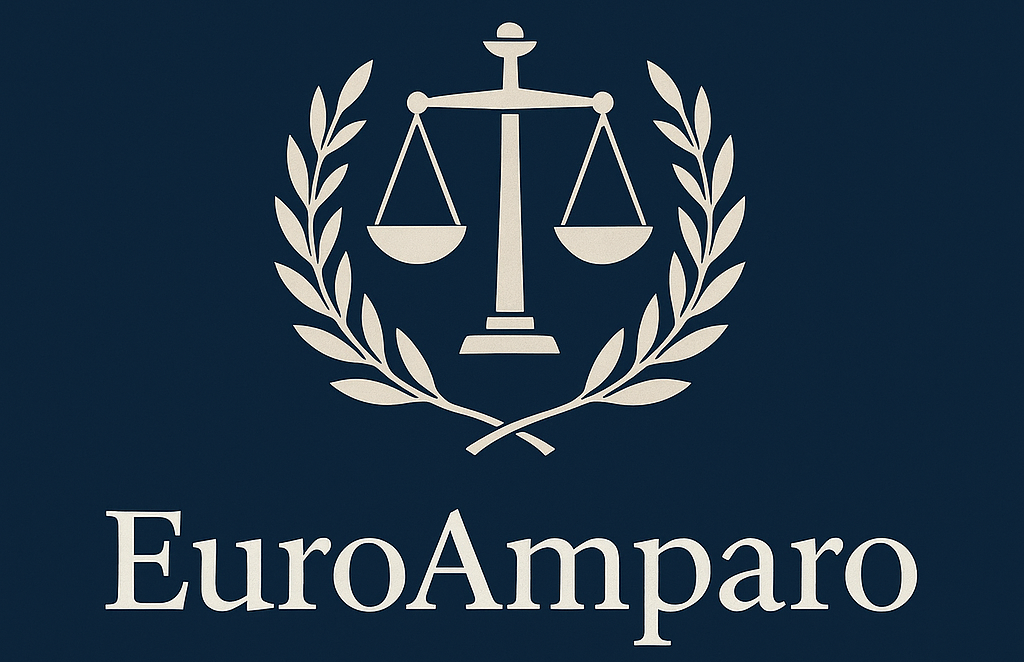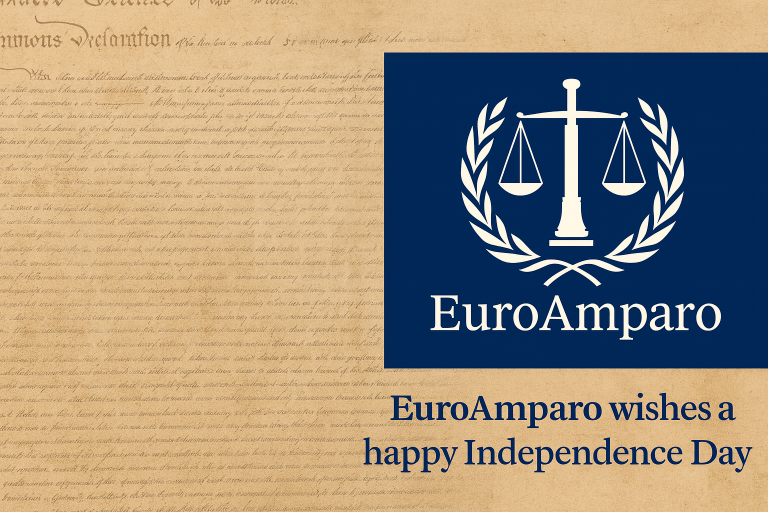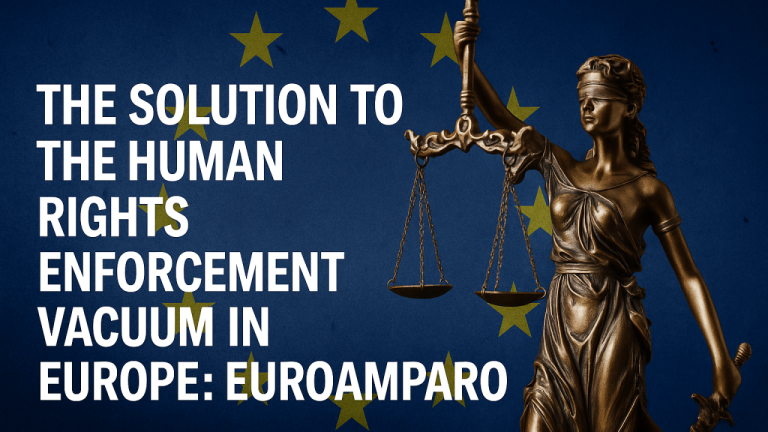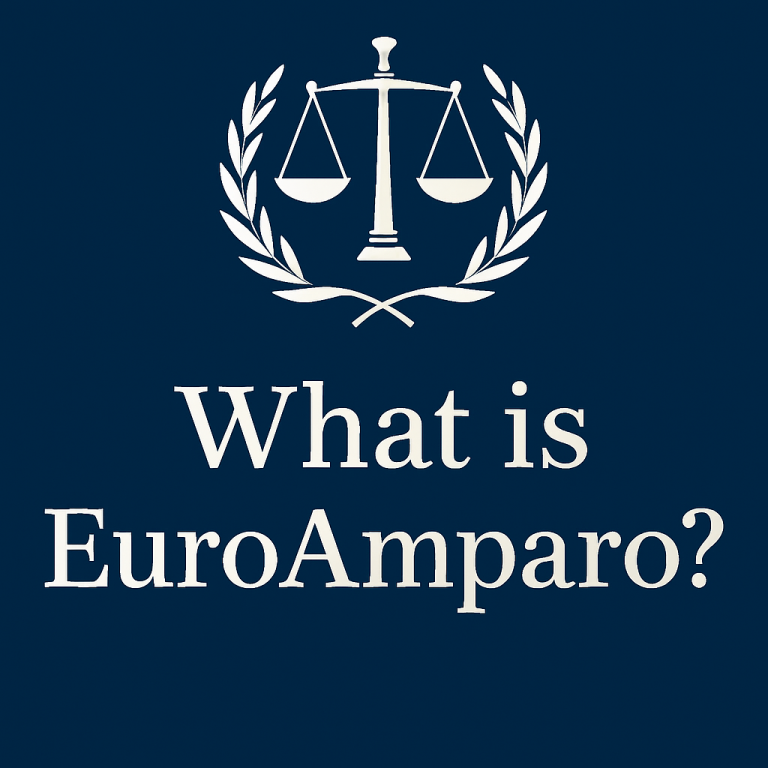 By Dr. Ernesto Briseno, MCIArb
By Dr. Ernesto Briseno, MCIArb
A Mechanism Rooted in the Union’s Founding Commitments
The Juicio de Amparo and its European counterpart, EuroAmparo are not merely a procedural tool. It an expression of constitutional dignity, an individual’s shield against institutional erosion, and a guardian of enforceable rights. It’s a proven system based in almost 2 centuries of tradition, since 1841 in Mexico.
In EU law, the spirit of EuroAmparo finds deep resonance in the foundational principles of:
- Human dignity which is inviolable and must be respected and protected (Article 1 CFR).
- Rule of law – “The Union is founded on the values of respect for human dignity, freedom, democracy, equality, the rule of law and respect for human rights, including the rights of persons belonging to minorities. These values are common to the Member States in a society in which pluralism, non-discrimination, tolerance, justice, solidarity and equality between women and men prevail.” (Article 2 TEU)
- Effective judicial protection (Article 47 CFR & Article 19(1) TEU)
- Fundamental rights as general principles of Union law (Article 6-19 TEU)
- Respect for international law and the ECHR and their hierarchy (Article 6(3) TEU)
- Freedoms and Fundamental Rights (Articles 6-19 CFR) and equality (Articles 20-26 CFR)
TFEU & THE CASE FOR ARTICLE 352
Article 352(1) TFEU:
“If action by the Union should prove necessary, within the framework of the policies defined in the Treaties, to attain one of the objectives set out in the Treaties, and the Treaties have not provided the necessary powers, the Council, acting unanimously on a proposal from the Commission and after obtaining the consent of the European Parliament, shall adopt the appropriate measures.”
Arguments for Article 352 of the TFEU as the Legal Basis for EuroAmparo
- The Treaties define clear objectives: rule of law, justice, fundamental rights.
- There is a gap in enforcement powers and remedies: no EU-wide tool exists to ensure justiciability of rights in real time, especially against national administrative action.
- No other specific Treaty provision provides for such a procedural guarantee, therefore
- Article 352 steps in to fill the void.
What EuroAmparo offers:
- Promotes values of the Union – Rule of law, dignity, democracy need enforceable remedies.
- Ensures rights and freedoms of individuals which with EuroAmparo would be protected at the point of violation.
- Provides citizens with a high level of justice specially in situations facing crossing borders and/or state abuse.
- Ensure legal certainty and effective remedies bridgeing enforcement gap in rights violations.
It would aim to fulfill the maxim ubi jus ibi remedium echoing Marbury v Madison.
RELATION TO THE ECHR & CHARTER
- European Convention on Human Rights (ECHR)
While not an EU instrument, the ECHR is part of the general principles of EU law (Article 6(3) TEU). EuroAmparo would reinforce:
- Article 6 ECHR – Right to a fair trial
- Article 13 ECHR – Right to an effective remedy
- Article 8 ECHR – Right to private and family life
- Article 14 ECHR – Non-discrimination in enjoyment of rights
It would also embody the positive obligation of States and the Union to provide effective remedies, in line with Strasbourg case law (Airey v. Ireland, Kudła v. Poland, Anayo v. Germany), which is settled law:
“The Convention is intended to guarantee not rights that are theoretical or illusory but rights that are practical and effective… This is particularly so of the right of access to the courts in view of the prominent place held in a democratic society by the right to a fair trial...”
Airey v Ireland, paragraph 24 (1979)
- Charter of Fundamental Rights of the European Union (CFR)
- Article 47 – Right to an effective remedy and to a fair trial
- Article 41 – Right to good administration
- Article 52(3) – Interpretation aligned with the ECHR
EuroAmparo ensures that these Charter rights are not symbolic, but operational.
SYSTEMIC JUSTIFICATION
What problems does EuroAmparo solve?
- Denial of access to justice by national administrative bodies, especially but not exclusively in migration, residence, consular, and family rights cases.
- Give real meaning to article 9 of the TEU that creates the “Citizenship of the Union”
- Structural inaction by EU bodies (e.g., SOLVIT) with no individual standing.
- No direct mechanism to suspend unlawful acts outside of long and costly judicial routes.
- No harmonized tool for emergency protection of Charter rights in national or cross-border cases.
Article 352 TFEU Justification Clause for EuroAmparo (Proposal)
Legal Basis and Justification under Article 352 TFEU
This instrument is adopted pursuant to Article 352(1) of the Treaty on the Functioning of the European Union, which permits the Union to take appropriate measures where action is necessary to attain the objectives of the Treaties, and no specific power is provided elsewhere.
The Union has committed itself under Articles 2 and 6 TEU, Article 19(1) TEU, and Articles 47–52 of the Charter of Fundamental Rights of the European Union, to uphold the values of rule of law, effective judicial protection, respect for human rights, and access to justice.
While various legal instruments provide for the recognition and declaration of rights, a systemic gap persists in the effective enforcement and real-time protection of such rights, particularly in cases of administrative silence, transnational barriers, consular decisions, or non-judicial institutional inaction.
Existing procedures before national courts or EU bodies are often fragmented, non-suspensive, or inaccessible to individuals facing immediate and irreparable harm. The absence of a harmonized mechanism that enables individuals to invoke and protect their fundamental rights against unlawful acts or omissions by public authorities acting within the scope of Union law undermines the full effect of the Treaties.
In light of the jurisprudence of the European Court of Human Rights (Airey v. Ireland, Kudła v. Poland, Anayo v. Germany) and the Union’s obligation to provide practical and effective remedies, this Regulation establishes a procedural mechanism—herein referred to as EuroAmparo—which enables individuals to challenge acts or omissions that infringe their Charter or Treaty-based rights, and to seek interim suspension of such measures where necessary to prevent irreversible harm.
Given that no specific provision of the Treaties empowers the Union to create such a general rights-enforcement procedure applicable across all relevant areas of Union law, Article 352 TFEU provides the appropriate legal basis for this initiative.
REAL CASE COMPARISON
Coman v. Romania
(CJEU) vs. EuroAmparo (Hypothetical Mechanism)
| Dimension | Reality in Coman (EU – Status Quo) | Hypothetical under EuroAmparo (Inspired by Mexican Amparo) |
| Who was Coman? | Romanian national married to US citizen in Belgium | Same |
| Legal conflict | Romania refused to grant residency to the US same-sex spouse | Same |
| Legal grounds of claim | EU free movement (Directive 2004/38/EC) + non-discrimination | Charter of Fundamental Rights + Directive 2004/38 + Treaty principles |
| Venue | Romanian national court referred question to CJEU | Independent EU-wide EuroAmparo chamber |
| Standing / Access | Indirect; required national litigation and preliminary reference | Direct standing by the individual (Coman) to invoke rights via EuroAmparo |
| Time to decision | ~5.5 years (initial suit filed in 2013, CJEU judgment in 2018) | ~3–6 months with urgent interim relief possible within days |
| Interim relief | None. Spouse remained in limbo (entry/residency uncertainty) | Yes. Suspension of refusal; temporary permit pending resolution |
| Power to suspend administrative act | Not available without separate injunction request | Inherent in EuroAmparo (as in Mexican suspensión provisional) |
| Scope of protection | Applied narrowly to free movement within EU | Broader: Charter, ECHR, general principles of law, human dignity |
| Final impact | CJEU ruled in Coman’s favor (recognition required for residence) | Same expected ruling, but much faster and with protective measures |
| Systemic failure addressed? | No structural follow-up; Romania remains slow in implementation | Structural compliance could be mandated and monitored via amparo-type review |
THE PROBLEMS IN COMAN (AS DECIDED)
- Coman and his spouse lived in Belgium, married there, and sought to move to Romania.
- Romanian authorities refused to recognize the marriage on the basis that Romanian law prohibits same-sex marriage.
- Legal challenge in Romania led to years of delay before the Romanian Constitutional Court referred the matter to the CJEU.
- The CJEU ruled in Coman’s favor, requiring Romania to treat the US spouse as a “spouse” under Directive 2004/38/EC, regardless of national law on same-sex marriage.
- However, even after the ruling, implementation has been slow and uneven.
MEXICAN JUICIO DE AMPARO: KEY FEATURES RELEVANT TO EUROAMPARO
| Feature | Description |
| Direct access | Any individual can file amparo directo or indirecto against public authority |
| Suspensive effect | Suspensión provisional can freeze effects of acts immediately |
| Expedited procedure | Protective measures can be granted within 24–72 hours in urgent cases |
| Scope of application | Applies to any act of public authority (administrative, legislative, judicial) |
| Constitutional & human rights filter | Grounds include violations of constitutional rights and international treaties |
| Appeals and revisions | Strong appellate structure, including access to Mexico’s Supreme Court in precedent-setting cases |
WHAT EUROAMPARO WOULD HAVE CHANGED IN COMAN
- No Years of Delay:
Coman would not have had to wait five years for his right to be confirmed by a supranational court.
He could have filed a EuroAmparo immediately upon Romania’s refusal, invoking both Directive 2004/38/EC and Articles 7, 9, and 21 CFR.
- Urgent Protective Measures:
A EuroAmparo court could have issued an interim suspension of Romania’s denial, allowing his husband to reside temporarily while the case was resolved. This mirrors the Mexican suspensión provisional.
- More Rights-Friendly Jurisdiction:
EuroAmparo would use Union-level human rights standards, independent of Romania’s restrictive constitutional view of marriage.
- Individual Access and Empowerment:
Coman would have had direct procedural access to invoke his rights under EU law without relying on national procedural bottlenecks or referral delays.
- Precedent and Structural Follow-Up:
A EuroAmparo judgment could include binding remedial orders and a mandate for compliance mechanisms, reducing foot-dragging by national authorities.
Had EuroAmparo existed, Coman v. Romania would have become:
- Faster: Rights affirmed within months, not years.
- More protective: With interim residence granted, not denied.
- More accessible: Without needing a Constitutional Court or preliminary ruling.
- More systemic: Addressing implementation failure, not just legal declaration.
This comparison demonstrates that EuroAmparo is not just a procedural invention, it is the missing operational enforcement pillar of the EU’s fundamental rights architecture.




